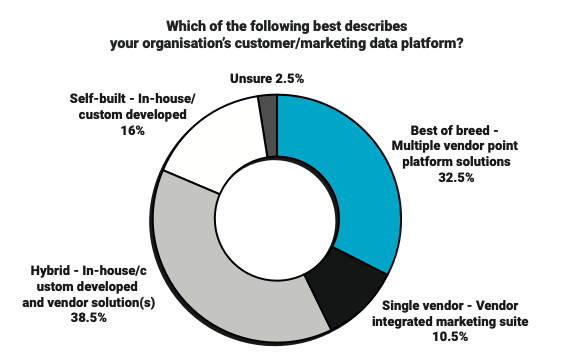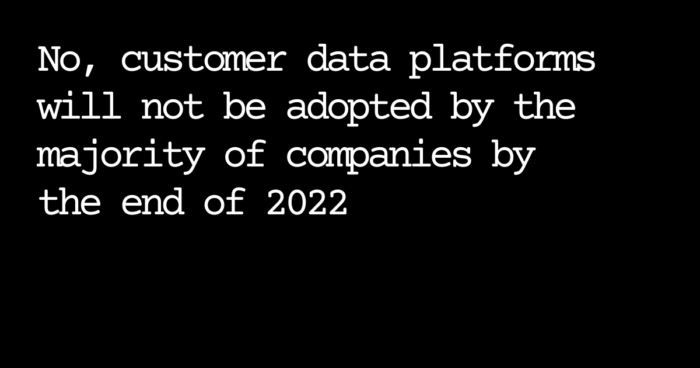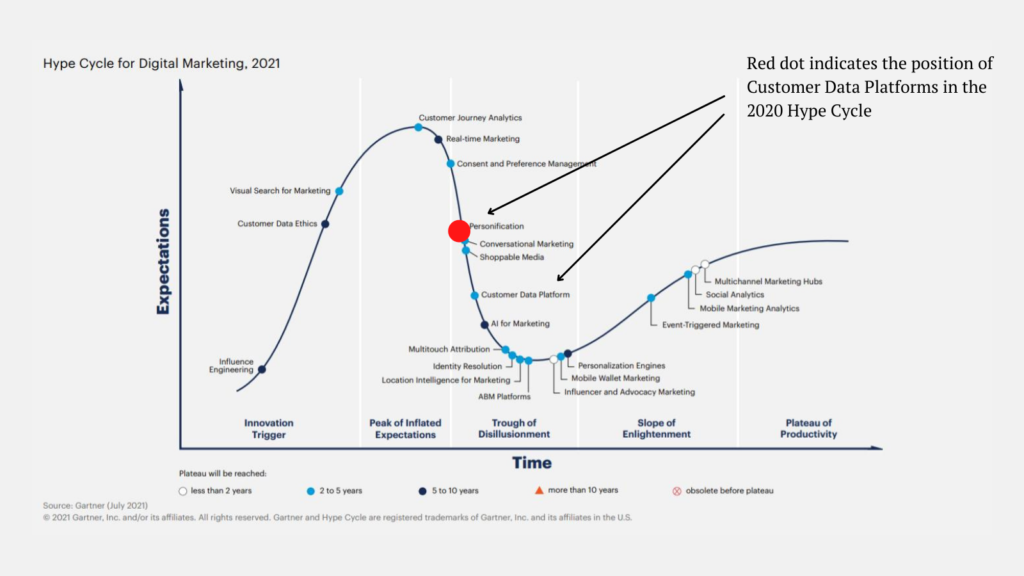This post comes late, but after reading a customer data platform vendor’s fanciful press release that “over 99% of marketers will achieve the single customer view, or golden record, by the end of 2022,” I couldn’t put it off any longer.
No, customer data platforms – let’s say it loud and clear – the majority of companies will not adopt them by the end of the year, at least not in the sense in which we are accustomed to considering them (we will discover that it is a short-sighted classification).
It will not happen for these reasons:
- Organisations are not ready. Marketers don’t have the skills to implement the platform themselves. And if the project is in the hands of the digital team, they are unlikely to have access to the data needed to make it an omnichannel project. That’s why IT has a crucial role to play, but I rarely hear of companies with infighting going on.
- Technology is expensive. ROI is a huge uncertainty, with a year’s licence often spent setting up the tool and who knows how many more wasted on understanding how to get the most out of it.
- Data protection policies change and – worst of all – do so on a local basis. Even the most structured companies are trembling at the prospect of severe sanctions, sometimes leading to heated internal discussions on how to interpret the regulations.
To paraphrase a famous saying, those who strive for the single customer view must learn to love the process, because it is not a goal but a journey. This is the approach I adopted when I proposed developing a CDP at Benetton, which is operational from September 2020 and has become a case history on Google’s blog.
Faced with such complexity and with an investment of the magnitude of a CDP (a 100k eur/year licence, the same amount for consultancy services to turn on a few connectors, two years of project work) would have been a suicide (at least for me). So I chose to approach an incremental project with a hybrid architecture, instead choosing one of the many emerging single-vendor solutions.
The result? I could boast about the savings – a quarter of the investment in terms of licences and consultancy and no long-term contractual obligations – or the release time, equal to five months of the project from kick-off to activation of the display campaigns using programming. However, the greatest satisfaction was the chance to design an evolutionary roadmap calibrated on what the prototype had taught us in terms of processes and necessary skills, having discovered that the customer data platform was the last thing in order of importance to enable personalization at scale.
The rest is history. A very interesting story, but one that I cannot tell you for obvious reasons of confidentiality.
Skepticism around hybrid approach
I was convinced that the approach was the right one, but the more I read things online, the more my confidence wavered. Hybrid architectures seemed more and more like heresy. So in April 2021, I started to actively participate in a community where they were talking about customer data platforms. Participants were discussing which approach was best between single-vendor, custom and hybrid. I presented my point of view, explaining that a hybrid approach can be a competitive advantage but must be supported by an appropriate organisational model.
I knew I was addressing a very hot topic, but I didn’t think I’d end up being quoted on CMS Wire in an article asking a question that has become a leitmotif since the martech landscape exploded, namely Do CDPs Really Make Marketers Independent of IT?
Even the most marketer-friendly CDPs require fairly advanced skills, education and training for a business person to master. Daniele Sghedoni, who led the build of an open CDP based on Google Cloud Platform for Benetton, agreed that a sound marketing ops team is the crux for marketing being able to derive value from the CDP deployment.
Even though I had detected some mistrust (even from market analysts with whom I had the opportunity to deal with) I was still convinced that a hybrid architecture was the ideal solution, although I was struggling to get a confirmation. At least until July, when the “Customer Experience Trends & Insights” report by the Martech Alliance was published, which showed, among other things, that almost 40% of companies were adopting a hybrid approach.

Gartner’s Hype Cycle for Digital Marketing published in September was also highly suspicious, showing a decline in enthusiasm for Customer Data Platforms, although customisation and omnichannel marketing remain at the heart of companies’ attention.
Finally, in November, the final post from Lee Hammond, which we’ll explore further below:
More modular approaches to customer data management are emerging in this context, and this “unbundled” approach better aligns with existing internal processes. Better alignment means less work, less redundancy, and more adoption by the company at large.
This post of mine, as I said, comes late. I’ve been planning for at least a couple of years to propose a different point of view to companies interested in adopting real omnichannel strategies. However, I want to believe that, given the increased awareness of all-in on a single technology, it is not that late.
What’s next here
What I am committed to doing over the next few weeks is answering a few questions.
- If we really want to talk about customer data platforms, what types do the market offer today?
- How is a reference architecture structured and what is the role of a customer data platform?
- Marketing, information systems, business intelligence, retail, vendors, consultants: how can we organise ourselves to obtain significant results?
- Which technologies enable this paradigm shift?
If you are interested in following the evolution of this path, enter your email address below (no, no newsletter, just a little longer than a tweet to report updates) or keep an eye on Linkedin and Twitter.

